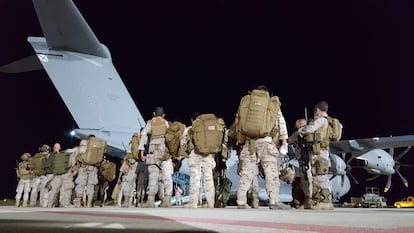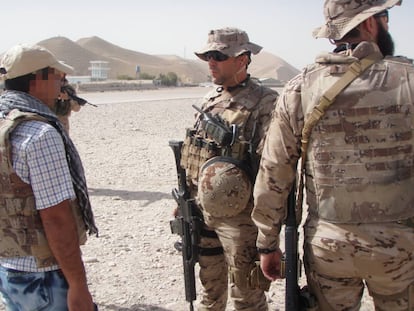First military plane due to repatriate Spanish nationals from Afghanistan takes off from Zaragoza
It is estimated the two A400M aircraft will be able to take between 500 and 600 people, meaning various flights will be necessary

At around 11.30pm on Monday evening, the first of two A400M military aircraft that will be used to repatriate Spanish nationals, embassy staff and Afghans from Kabul took off from the Spanish air base at Zaragoza. The plane, which was due to travel first to Dubai, was carrying a team from the Military Civic Cooperation (CIMIC) battalion from the army as well as a team from the air force’s EADA unit, an air support squadron. These teams will be in charge of the evacuation effort.
The second A400M plane is due to leave from the same air base today, Tuesday, at 9am, according to a joint statement from the Defense and Foreign Affairs ministries. Each of the aircraft has a capacity for 116 soldiers and are estimated to be able to repatriate between 500 and 600 people, meaning that several flights will be necessary.
Spanish staff were “urgently” transferred from the embassy via helicopter and then relocated to a “security zone” near the airport
Interior Minister Fernando Grande-Marlaska said on Monday morning that staff from the Spanish embassy in Kabul had already been moved to Kabul airport, where he trusted they could be evacuated “as soon as possible.” Among those staff are officers from the police UIP and GEO special forces units, which are in charge of security at the embassy in the Afghan capital. Kabul, like much of the rest of Afghanistan, has now fallen under the control of the Taliban after a lightning offensive. In an interview with the Cadena SER radio network, Marlaska added that the situation was “safe for our countrymen.”
Sources close to the group of people waiting to be evacuated to Spain have clarified that they have been in an area “close” to the airport since Sunday evening. The Kabul airport has seen chaotic scenes in recent days as Afghans tried to board planes in a desperate bid to escape the advancing Taliban. The Spanish staff were “urgently” transferred from the embassy via helicopter on Sunday morning to the airport, and hours later they were relocated to a “security zone” near the airport, where they are now awaiting the arrival of the planes to take them out of the country, Patricia Ortega Dolz reports. The images circulating on Monday from the airport showed people hanging from planes as they took off. At least five people died trying to reach the runway.
Also on Monday, Spanish Foreign Affairs Minister José Manuel Albares offered help to the North Atlantic Treaty Organization (NATO) and the European Union (EU) to repatriate staff from these organizations from Afghanistan. The head of Spain’s diplomatic service spoke to NATO secretary general Jens Stoltenberg, as well as the EU’s High Representative Josep Borrel, according to a statement released by his department.
Albares explained the evacuation plans to them, and expressed the “willingness of the government” to support the efforts of the EU and NATO by “transferring staff from both organizations” to Spain as a point of entry into the EU. The government has been coordinating these plans – about which little more is known for security reasons – with its partners and allies so as to offer a “joint response” to the crisis, the Foreign Ministry has pointed out.
English version by Simon Hunter.
Tu suscripción se está usando en otro dispositivo
¿Quieres añadir otro usuario a tu suscripción?
Si continúas leyendo en este dispositivo, no se podrá leer en el otro.
FlechaTu suscripción se está usando en otro dispositivo y solo puedes acceder a EL PAÍS desde un dispositivo a la vez.
Si quieres compartir tu cuenta, cambia tu suscripción a la modalidad Premium, así podrás añadir otro usuario. Cada uno accederá con su propia cuenta de email, lo que os permitirá personalizar vuestra experiencia en EL PAÍS.
¿Tienes una suscripción de empresa? Accede aquí para contratar más cuentas.
En el caso de no saber quién está usando tu cuenta, te recomendamos cambiar tu contraseña aquí.
Si decides continuar compartiendo tu cuenta, este mensaje se mostrará en tu dispositivo y en el de la otra persona que está usando tu cuenta de forma indefinida, afectando a tu experiencia de lectura. Puedes consultar aquí los términos y condiciones de la suscripción digital.
More information
Últimas noticias
There is as much life left to discover on planet Earth as that which is already known
Dozens presumed dead, around 100 injured in fire at Swiss Alps bar during New Year’s celebration
Is porn for women different from conventional porn? We spoke to those who make it
Cartagena de Indias is sinking: What can the city do to mitigate it?
Most viewed
- Reinhard Genzel, Nobel laureate in physics: ‘One-minute videos will never give you the truth’
- Sinaloa Cartel war is taking its toll on Los Chapitos
- David King, chemist: ‘There are scientists studying how to cool the planet; nobody should stop these experiments from happening’
- Oona Chaplin: ‘I told James Cameron that I was living in a treehouse and starting a permaculture project with a friend’
- The Interoceanic Train, the Mexican alternative to the Panama Canal











































